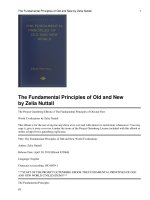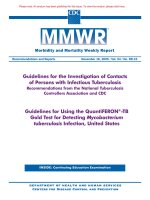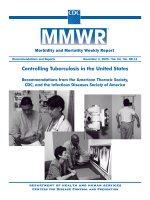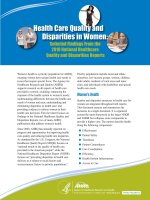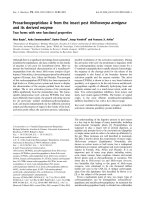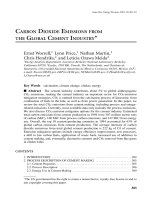Addressing Air Emissions from the Petroleum Refinery Sector Risk and Technology Review and New Source Performance Standard Rulemaking pptx
Bạn đang xem bản rút gọn của tài liệu. Xem và tải ngay bản đầy đủ của tài liệu tại đây (632.19 KB, 52 trang )
Addressing Air Emissions from the
Addressing
Air
Emissions
from
the
Petroleum Refinery Sector
Risk and Technology Review and New Source
Risk
and
Technology
Review
and
New
Source
Performance Standard Rulemaking
Public Outreach Presentation
US Environmental Protection Agency
Office of Air Quality Planning and Standards
Research Triangle Park, NC
Purpose of this Webinar
► To engage communities, particularly environmental justice
communities in a dialog about the development of this
communities
,
in
a
dialog
about
the
development
of
this
rulemaking early in the process
► Part of EPA’s overall outreach strategy to stakeholders
►
Builds on EPA
’
s earlier Clean Air Act 101 webinar for
►
Builds
on
EPA s
earlier
Clean
Air
Act
101
webinar
for
communities
► Rulemaking combines several regulatory programs including
programs that look at risk and those that don’t
Outline
► The Petroleum Refining Sector
►
The Clean Air Act and Refinery Rulemakings
►
The
Clean
Air
Act
and
Refinery
Rulemakings
► Refinery Process and Emissions
► Health Effects
► Potential Amendments
► Public Involvement in the Upcoming Rulemaking
► Q and A
► Appendix with Reference Materials
PUitdCtl
►
P
rocess
U
n
it
s an
d
C
on
t
ro
l
s
► Additional GHG Information
2
Petroleum Refinery Background
Approximately 90% of the petroleum products produced
in the United States are fuels
in
the
United
States
are
fuels
Motor vehicle gasoline accounts for about 40% of the
total out
p
ut from refineries
p
Located near crude oil sources or in heavily
industrialized areas
NEtdWtCt lti t l th
N
ear
E
as
t
an
d
W
es
t
C
oas
t
popu
l
a
ti
on cen
t
ers, a
l
ong
th
e
Gulf Coast, and throughout the Midwest
Go to
http://www eia gov/neic/rankings/refineries htm
for
Go
to
http://www
.
eia
.
gov/neic/rankings/refineries
.
htm
for
a current list of top refineries, their locations, and
throughputs
Refineries Emit a Wide Variety of
Pollutants
► Criteria Air Pollutants (CAP)
►
Sulfur dioxide SO
2
►
Sulfur
dioxide
SO
2
► Oxides of Nitrogen NO
X
► Carbon Monoxide CO
► Particulate Matter (PM)
► Volatile Organic Compounds (VOC)
► Organic compounds that are photochemically reactive
►
Other Pollutants
►
Other
Pollutants
► Greenhouse Gases (GHG)
► Hydrogen Sulfide (H
2
S)
►
Hazardous Air Pollutants (HAP)
►
Hazardous
Air
Pollutants
(HAP)
► Carcinogenic HAP, including benzene, naphthalene,1,3-butadiene, PAH
► Non-carcinogenic HAP, including HF and HCN
► Persistent bioaccumulative HAP, including mercury
The Petroleum Refinery Sector
► 150 domestic refineries
► 17 MMbbls/day crude throughput, refining
~
20% of world crude
production
~
20%
of
world
crude
production
► Refineries have hundreds of emission
points
► Second largest industrial source of GHGs
Pollutant 2005 National
Emissions
Inventory (NEI)
Emissions (TPY)
Emissions
(TPY)
NO
x
146,185
SO
2
247,239
VOCs 114,852
HAP 14,000
PM
2.5
30,333
(GHGs) 220 MMTCO
2
e
3
5
The Clean Air Act and
Refinery Rulemakings
What does the Clean Air Act (CAA)
Require?
Require?
► New Source Performance Standards (NSPS)
►
CAA Section 111(b) requires to EPA to set and periodically review emission
►
CAA
Section
111(b)
requires
to
EPA
to
set
and
periodically
review
,
emission
standards for new sources of criteria air pollutants (CAP), volatile organic
compounds (VOC), and other pollutants.
►
Air Toxics Rules: Maximum Achievable Control Technology (MACT) and
►
Air
Toxics
Rules:
Maximum
Achievable
Control
Technology
(MACT)
and
Residual Risk and Technology Reviews
► CAA Section 112(d) requires the EPA to set emissions standards for
hazardous air pollutants (HAP) emitted by major stationary sources based
hazardous
air
pollutants
(HAP)
emitted
by
major
stationary
sources
based
on performance of the maximum achievable control technology (MACT).
► EPA is required to conduct 2 reviews and update the existing standards if
necessary
necessary
► Residual Risk Assessment: To determine whether additional emission reductions are
warranted to protect public health or the environment. This is a one-time review.
► Technology Reviews: To determine if better emission control approaches, practices, or
processes are now available. Technology reviews are required every eight years.
What We Have Done So Far
NSPS
► 1974 NSPS –covers fuel gas combustion devices, FCCU, and sulfur plants
2008 NSPS
bddld
k
fl d h t ifi ll
►
2008
NSPS
–
covers same a
b
ove an
d
d
e
l
aye
d
co
k
ers,
fl
ares an
d
process
h
ea
t
ers spec
ifi
ca
ll
y
► Received 3 petitions for reconsideration
► Addressed a portion of the reconsideration issues
MACT
MACT
► Promulgated 2 MACT Standards for Refineries
► 1995 MACT (known as MACT 1) covers non-combustion or evaporative sources, such as
equipment leaks, tanks, wastewater, miscellaneous process vents; amended to cover heat
exchange systems, including cooling towers.
► 2002 MACT (known as MACT 2) covers combustion sources: Catalytic Cracking Units,
Catalytic Reforming Units, and Sulfur Recovery Units
Risk and Technology Review (RTR)
► 2007 proposed Risk and Technology Review amendments for non-combustion sources
► 2009 withdrew amendments related to risk review due to insufficient data; amendments
promulgated for heat exchanger systems.
promulgated
for
heat
exchanger
systems.
8
What This Rulemaking Will Do
► NSPS - Address remaining reconsideration issues,
including GHG
► MACT 1 and 2 - Propose and promulgate RTR
amendments and evaluate whether additional rule
amendments
and
evaluate
whether
additional
rule
revisions are necessary
►
Respond to issues raised in litigation and petitions
►
Respond
to
issues
raised
in
litigation
and
petitions
12
Refinery Processes and Emissions
Refinery
Processes
and
Emissions
How much HAP do these sources emit
with existin
g
controls in
p
lace?
gp
Petroleum Refinery HAP Emissions (tons per year)
Fl
1184
2825
Ei t Lk
Fl
ares
Miscellaneous
FCCU
4018
1385
E
qu
i
pmen
t L
ea
k
s
FCCU
Combustion
2105
2303
Cooling towers
3992
1714
Source: ICR data
,
2010
Wastewater Treatment
Storage
13
How much GHG do these sources emit?
Flaring
Sulfur Plant
1.9%
Fluid Catalytic
Cracking Units
Flaring
1.6%
H2 Plant
2.7%
Cat Coke
Asphalt Blowing
0.10%
Blowdown
0 18%
Cooling Towers
0 003%
Cracking
Units
Other
0.8%
Equipment Leaks
0.014%
Delayed Coking
0.058%
25.2%
0
.
18%
0
.
003%
Combustion
67.7%
Wastewater
Treatment
0.43%
Storage Tanks
0.007%
Process
Heaters and
Boilers
August 8, 2008;
TECHNICAL SUPPORT DOCUMENT FOR THE PETROLEUM REFINING SECTOR: PROPOSED RULE FOR
Boilers
August
8,
2008;
TECHNICAL
SUPPORT
DOCUMENT
FOR
THE
PETROLEUM
REFINING
SECTOR:
PROPOSED
RULE
FOR
MANDATORY REPORTING OF GREENHOUSE GASES
4
HealthEffectsofRefiner
y
Emissions
y
Health Effects of Criteria Air Pollutants
Compound Health Effect
Sulfur Dioxide (SO
2
) and
Oxides of Nitrogen (NO
x
)
Array of adverse respiratory effects, airway inflammation in
healthy people, increased respiratory symptoms in people
with asthma
Carbon Monoxide (CO) Harmful health effects associated with the reduction of
oxygen delivery to the body's organs (heart and brain) and
tissues
Particulate Matte
r
Increased res
p
irator
y
s
y
m
p
toms
,
irritation of the airwa
y
s
,
pyyp, y,
coughing, or difficulty breathing, decreased lung function;
aggravated asthma; development of chronic bronchitis;
irregular heartbeat; nonfatal heart attacks; and premature
death in
p
eo
p
le with heart or lun
g
pp g
16
Health Effects of Risk Driving HAP
Compound Acute Chronic
Benzene Neurological effects,
irritation of the eye, skin and
respiratory tract
Blood disorders (reduced
number of red blood cells
and aplastic anemia),cancer
1,3-Butadiene Irritation of the eyes, throat
and respiratory tract
Cardiovascular effects,
leukemia, cancer
Na
p
hthalene Hemol
y
tic anemia, dama
g
e Cataracts, dama
g
e to the
p
yg
to the liver, neurological
effects
g
retina, hemolytic
anemia,cancer
PAHs Skin disorders, depression Skin disorders (dermatitis,
of the immune system photosensitization),
depression of the immune
system, damage to the
respiratory tract, cataracts,
17
cancer
Health Effects of Other Pollutants
Compound Mechanism Health Effect
Volatile Organic Compounds
(VOC)
Combine with NOx
in sunlight to
Significantly reduce lung function and
induce respiratory inflammation in
create ozone normal, healthy people during
periods of moderate exercise,
symptoms include chest pain,
coughing, nausea, and pulmonary
congestion
Greenhouse gases (GHG),
including Methane (CH
4
),
Carbon Dioxide (CO
2
),
Compounds with
high global
warming potential
Increase in average temperatures,
higher levels of ground-level ozone,
increased drought, harm to water
Nitrous Oxide (N
2
O) contribute to
climate change
resources, ecosystems and wildlife,
health risk to sensitive populations
18
Basics of Risk and Technology
Review
Review
► Risk Review
►
CAA Section 112 (f)(2) requires EPA to review the MACT standard 8 years after it is
►
CAA
Section
112
(f)(2)
requires
EPA
to
review
the
MACT
standard
8
years
after
it
is
promulgated to determine if the MACT standard is sufficiently protective for human health
and the environment
► If any person is exposed to a risk greater than 1 in a million, EPA goes through a 2-step
process to e al ate hether that risk can be red ced
process
to
e
v
al
u
ate
w
hether
that
risk
can
be
red
u
ced
► Step 1 – Tighten MACT standard if any person exposed greater than 100 in a million
► Step 2 – Tighten MACT standard to reduce individual risk and population risk to the
g
reatest extent
p
ossible considerin
g
costs, technical feasibilit
y
and other im
p
acts
gp g yp
► Technology Review
► NSPS - Section 111(b)(1)(B) requires EPA to periodically review and revise these standards
of performance, as necessary, to reflect improvements in methods for reducing emissions.
► MACT
–
Section 112(d)(6) requires EPA to review the MACT standard every 8 years
considering advances in technologies and operational practices
What will the risk results show?
► The CAA requires us to determine the highest risk or the
Maximum Individual Risk (MIR) expressed as
“
xina
Maximum
Individual
Risk
(MIR)
expressed
as
x
in
a
million”.
► This re
p
resents the hi
g
hest excess cancer risk for a
pg
receptor from the refinery source category with a 70 year
period exposure period taking into account the distance
from the refinery to the receptor and site
-
specific
from
the
refinery
to
the
receptor
and
site
specific
meteorological conditions
► In our analysis we will identify the risk-driving HAP and
specific source risk contribution
► We also perform a demographic analysis of risk.
Potential Amendments
Rulemaking Strategy
Rulemaking
Strategy
•
Make refineries subject to uniform standards
Make
refineries
subject
to
uniform
standards
• AmendMACTandNSPStocoverthe
remaining emission points of concern
remaining
emission
points
of
concern
• Addressrulegaps
• Addressstartup,shutdownandmalfunction
(SSM)provisions
What are Uniform Standards?
► EPA developed consistent emission source standards to
replace existing standards across the chemical and
replace
existing
standards
across
the
chemical
and
refinery sectors
► The
y
a
pp
l
y
to
yppy
► equipment leaks
► storage vessels and transfer operations
► closed vent s
y
stems and control devices
(
flares
)
y()
► heat exchange systems
► Strengthen requirements considering technologies and
costs
costs
► Satisfy technology review requirements for MACT and
NSPS
Other Amendments to MACT and
NSPS
NSPS
► Emission points not covered by uniform standards:
Dl d
k
►
D
e
l
aye
d
co
k
ers
► Fluid catalytic cracking units (FCCU)
►
NO
X
and PM limits
►
NO
X
and
PM
limits
► Reformers
► Fenceline monitoring
► GHG standards
► Other NSPS reconsideration Issues
► SSM and rule gaps
Fenceline Monitoring Approach
► Refineries contain hundreds of emission points (air toxics and criteria pollutants)
► Some emission points are well-understood and well-characterized
► Others (mostly fugitive ground-level sources) not well characterized in the inventories
• Fugitives from process piping
• Wastewater sources
•
PRV releases
•
PRV
releases
• Tankage
• Unplanned or unknown emission sources (e.g., not on the books)
► Highest concentrations of these ground-level sources outside the facility likely occur
by the property boundary near ground level
by
the
property
boundary
near
ground
level
► Air monitoring at the property boundary can provide a direct measure of the annual
average concentrations of these air toxics directly surrounding the refinery
► Provides a more certain measure of the risk from these sources than our current
approach
30


